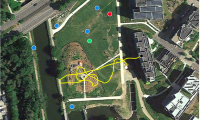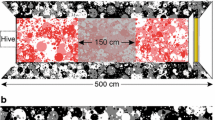Abstract
Previous studies with Oriental Fruit Moth (OFM, Grapholita molesta) and Heliothis virescens males flying upwind along a pheromone plume showed that they increased their upwind flight speed as they flew higher above striped floor patterns and, for OFM, to a similar degree over dotted floor patterns. This response pattern has been demonstrated in another moth species, Epiphyas postvittana and in a beetle, Prostephanus truncatus. In all cases the role played by the change in angular size of the wind tunnel’s ventral floor pattern was not assessed. In the present study we specifically addressed this question with a systematic examination of moths’ flight control over different sizes of transverse stripes and dot patterns ranging down by halves from 5 to 0.625 cm and a blank white floor as a control, and showed that OFM males fly faster upwind and along their flight paths over floor patterns of decreasing size. Increased speeds over striped patterns were evident as stripe width decreased below 2.5 cm, whereas moths did not increase their flight speed over dot patterns until dot size had decreased to less than 1.25 cm. Another flight component that the moths can actively control, their course angles, was unchanged above both patterns, except for moths flying over 5 cm stripes. Turning frequency and interturn distances were mostly unchanged or offset each other, negating any effects on upwind progress. As in an earlier study examining flight speeds at three heights above floor patterns of three densities, the moths’ changes in speed appear to be exclusively affected by changes in their orthokinetic response to the size of the floor pattern objects.




Similar content being viewed by others
References
Baker TC (1989) Pheromones and flight behavior. In: Goldsworthy GJ, Wheeler CH (eds) Insect flight. CRC Press, Boca Raton, pp 231–255
Baker TC (1990) Upwind flight and casting flight: complimentary phasic and tonic systems used for location of sex pheromone sources by male moths. In: Døving KB (ed) Tenth international symposium on olfaction and taste. Graphic Communication System A/S. Oslo, Norway, pp 18–25
Baker TC, Cardé RT (1979a) Endogenous and exogenous factors affecting periodicities of female calling and male sex pheromone response in Grapholitha molesta (Busck). J Insect Physiol 25:943–950
Baker TC, Cardé RT (1979b) Analysis of pheromone-mediated behaviours in male grapholitha molesta, the oriental fruit moth (Lepidoptera: Tortricidae). Environ Entomol 10:956–968
Baker TC, Kuenen LPS (1982) Pheromone source location by flying moths: a supplementary non-anemotactic mechanism. Science 216:424–426
Baker TC, Roelofs WL (1981) Initiation and termination of oriental fruit moth male response to pheromone concentrations in the field. Environ Entomol 10:211–218
Baker TC, Willis MA, Phelan PL (1984) Optomotor anemotaxis polarizes self-steered zigzagging in flying moths. Physiol Entomol 9:365–376
Batschelet E (1981) Circular statistics in biology. Academic, New York
Cardé RT (1984) Chemo-orientation in flying insects. In: Bell WJ, Cardé RT (eds) Chemical ecology of insects. Chapman and Hall, London, pp 111–124
Cardé RT (1986) Epilogue: behavioural mechanisms. In: Payne TL, Birch MC, Kennedy CEJ (eds) Mechanisms in insect olfaction. Clarendon, Oxford, pp 175–186
Cardé RT, Hagaman TE (1979) Behavioural responses of the gypsy moth in a wind tunnel to air-borne enantiomers of disparlure. Environ Entomol 8:475–484
Cardé RT, Minks AK (1997) Pheromone research: new directions. Chapman and Hall, New York
Cardé AM, Baker TC, Cardé RT (1979) Identification of a four-component sex pheromone of the female oriental fruit moth, Grapholitha molesta (Lepidoptera: Tortricidae). J Chem Ecol 5:423–427
Charlton RE, Kanno H, Collins RD, Cardé RT (1993) Influence of pheromone concentration and ambient temperature on flight of the gypsy moth, Lymantria dispar, in a sustained flight wind tunnel. Physiol Entomol 18:349–362
Fadamiro HY, Wyatt TD, Birch MC (1998) Flying beetles respond as moths predict: optomotor anemotaxis to pheromone plumes at different heights. J Insect Behav 11:549–557
Foster SP, Howard AJ (1999) The effects of source dosage, flight altitude, wind speed, and ground pattern on sex pheromone-mediated flight manoeuvres of male lightbrown apple moth, Epiphyas postvittana (Walker). N Z J Zool 26:97–104
Fraenkel G, Gunn DL (1961) The orientation of animals: kineses, taxes, and compass reactions. Dover, New York
Haynes KF, Baker TC (1989) An analysis of anemotactic flight in female moths stimulated by host odour and comparison with the males’ response to sex pheromone. Physiol Entomol 14:279–289
Heath RR, Manukian A (1992) Development and evaluation of systems to collect volatile semiochemicals from insects and plants using a charcoal-infused medium for air purification. J Chem Ecol 18:1209–1226
Kennedy JS (1939) The visual responses of flying mosquitoes. Proc Zoo Soc Lond A 109:221–242
Kennedy JS (1951) The migration of the desert locust (Schistocerca gregaria Forsk.). Phil Trans R Soc Lond B Biol Sci 235:163–290
Kennedy JS (1977) Olfactory responses to distant plants and other odor sources. In: Shorey HH, McKelvey JJ Jr (eds) Chemical control of insect behavior. Wiley-Interscience, New York
Kennedy JS (1978) The concepts of olfactory “arrestment” and “attraction”: a review. Physiol Entomol 3:91–98
Kennedy JS (1983) Zigzagging and casting as a programmed response to wind-borne odour: a review. Physiol Entomol 8:109–120
Kennedy JS, Marsh D (1974) Pheromone-regulated anemotaxis in flying moths. Science 184:999–1001
Kennedy JS, Ludlow AR, Sanders CJ (1980) Guidance system used in moth sex attraction. Science 288:475–477
Kennedy JS, Ludlow AR, Sanders CJ (1981) Guidance of flying male moths by wind-borne sex pheromone. Physiol Entomol 6:395–412
Kuenen LPS (2013) Flying faster: flight height affects orthokinetic responses during moth flight to sex pheromone. J Insect Behav 26:57–68
Kuenen LPS, Baker TC (1982a) Optomotor regulation of ground velocity in moths during flight to sex pheromone at different heights. Physiol Entomol 7:193–202
Kuenen LPS, Baker TC (1982b) The effects of pheromone concentration on the flight behaviour of the oriental fruit moth. Physiol Entomol 7:23–434
Kuenen LPS, Cardé RT (1993) Effects of moth size on velocity and steering during upwind flight toward a sex pheromone source by Lymantria dispar (Lepidoptera: Lymantriidae). J Insect Behav 6:177–193
Kuenen LPS, Cardé RT (1994) Strategies for recontacting a lost pheromone plume: casting and upwind flight in the male gypsy moth. Physiol Entomol 19:15–29
Kuenen LPS, Rowe HC (2006) Cowpea weevil flights to a point source of female sex pheromone: analyses of flight tracks at three wind speeds. Physiol Entomol 31:103–109
Mafra-Neto A, Cardé RT (1994) Fine-scale structure of pheromone plumes modulates upwind orientation of flying moths. Nature 369:142–144
Marsh D, Kennedy JS, Ludlow AR (1978) An analysis of anemotactic zigzagging flight in male moths stimulated by pheromone. Physiol Entomol 3:221–240
Roelofs WL, Comeau A, Selle R (1969) Sex pheromone of the oriental fruit moth. Nature 224:723
SAS (2010) SAS/STAT user’s guide. SAS Institute, Cary
Vickers NJ, Baker TC (1994) Reiterative responses to single strands of odour promote sustained upwind flight and odour source location by moths. PNAS USA 91:5756–5760
Willis MA, Arbas EA (1991) Odour-modulated upwind flight of the sphinx moth, Manduca sexta L. J Comp Physiol A 169:427–440
Willis MA, Arbas EA (1998) Variability in odor-modulated flight by moths. J Comp Physiol A 182:191–202
Willis MA, Baker TC (1988) Effects of varying sex pheromone component ratios on the zigzagging flight movements of the oriental fruit moth, grapholita molesta. J Insect Behav 4:357–371
Willis MA, Cardé RT (1990) Pheromone-modulated optomotor response in male gypsy moths, Lymantria dispar (L.) upwind flight in a pheromone plume in different wind velocities. J Comp Physiol A 167:699–706
Yokoyama VY, Miller GT, Hartsell PL (1987) Development of oriental fruit moth (Lepidoptera: Tortricidae) on a laboratory diet. J Econ Entomol 80:272–276
Acknowledgments
We thank Sarah Hofer for assistance in rearing insects, making the floor patterns and digitizing the moth tracks. This work was funded in part by funds from the California Pistachio Research Board.
Mention of trade names or commercial products in this article is solely for the purpose of providing specific information and does not imply recommendations or endorsement by the U.S. Department of Agriculture. USDA is an equal opportunity provider and employer.
Author information
Authors and Affiliations
Corresponding author
Rights and permissions
About this article
Cite this article
Kuenen, L.P.S., Gilbert, C. & Siegel, J. Flying Slower: Floor Pattern Object Size Affects Orthokinetic Responses During Moth Flight to Sex Pheromone. J Insect Behav 27, 581–592 (2014). https://doi.org/10.1007/s10905-014-9450-8
Revised:
Accepted:
Published:
Issue Date:
DOI: https://doi.org/10.1007/s10905-014-9450-8




